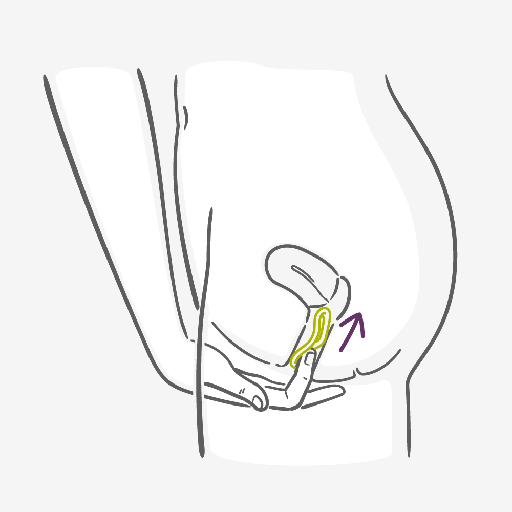PROS OF CONTRACEPTION RING
- Highly effective female birth control method1
- It´s easy to put in and take out2
- You don't have to think about it every day2
- It doesn’t interrupt sex2

CONS OF CONTRACEPTION RING
- You need to remember to change it and put in a new one2
- You may not feel comfortable inserting or removing it from your vagina, it may cause increased vaginal discharge2
- It may cause temporary side effects of hormonal birth control, such as headaches, nausea, breast tenderness and mood changes2
- You can have spotting and bleeding in the first few months2
- Some medicines can make the ring less effective2
- The ring doesn't protect against STIs2
*STI : sexually transmitted infection

PUT A RING ON IT
The contraceptive ring looks a lot like a cross between a bracelet and an elastic band, simple and functional – but it’s a whole lot smarter than that. It is a clear and flexible ring of polyethylene vinyl acetate that, once inserted into the vagina, slowly releases the hormones progestin and estrogen into your body to stop the ovaries from releasing eggs. It also thickens the cervical mucus, which keeps the sperm from getting to the egg.
It stays in place for 3 weeks, and then you remove it, take a week off then pop another one in.

HOW TO
The ring sits up against your vaginal wall so putting it in is just the same as using a tampon, but because of its shape you might find it a little tricky, but most users swear by the pinch it and twist technique. Start by washing your hands then squeeze it between your finger and thumb and push it up inside you until it’s sitting up against the side of your vaginal wall. Once it’s in, make sure you’re comfortable with its position. You don’t even need to take it out for sex. Leave it there for 3 weeks then remove, and a week later replace with a new one. Your menstrual period should start during this ring-free week. If the ring falls out and stays out for more than 3 hours, replace it but use another method of contraception, like a condom, until the ring has been in place for 7 days in a row. Make sure you read the directions and talk to your healthcare provider about what to do.
PROS / CONS
- Highly effective
- It´s easy to insert and to remove
- It doesn’t require daily attention
- It permits sexual spontaneity and doesn’t interrupt sex
- It requires keeping track of the number of weeks inserted
- It may cause vaginal discharge, discomfort in the vagina, and irritation
- It may cause some people to suffer headaches and mood swings
- It may cause disrupted periods
- It may cause weight gain
- Other risks are similar to oral contraceptives (combined pill)
- Does not protect against HIV infection (AIDS) and other sexually transmitted infections (STIs)
GIRLS TALK
FREQUENTLY ASKED QUESTIONS
The ring can slip or accidentally come out of your vagina during sexual intercourse, bowel movements, or when removing a tampon. If the ring falls out, it should be rinsed off and replaced as soon as possible. If it has been out for less than three hours, you should still be protected against pregnancy. If it has been out for more than 3 hours, a back-up method of contraception, such as condoms, is needed for the next seven days. The ring must stay in for at least 7 more days after being out for longer than 3 hours; this may mean that you wear it for more than 21 days in total that month. Following this, a one-week ring-free interval can occur and the next ring inserted.
The ring may break, which can cause the ring to lose its shape. If the ring stays in your vagina, this should not lower the effectiveness at preventing pregnancy. If the vaginal ring breaks and slips out of your vagina, throw the broken ring in the trash and insert a new vaginal ring.
If you leave the contraceptive ring in your vagina for up to 4 weeks (28 days) you will still be getting pregnancy protection. Remove your old vaginal ring for 1 week (7 days) and insert a new one 1 week (7 days) later.
If you leave the contraceptive ring in your vagina longer than 4 weeks (28 days), remove the ring immediately, check to make sure you are not pregnant and insert a new ring and use a back-up method of contraception for the next 7 days. You may have irregular bleeding, or no period that month.
You must use another contraceptive method, such as condoms, until the new vaginal ring has been used for 7 days in a row.
It is important to consult with your doctor or healthcare provider to make sure you are not pregnant before start with the vaginal ring. Talk to your doctor or healthcare provider for more details and read the patient information leaflet for basic directions on how to start using the vaginal ring.
Insert the ring as soon as you remember and use a back-up contraceptive method for 7 days. If you have unprotected sex after the ring has been out for more than one week, consider using emergency contraception. You should not have more than 7 days without wearing a ring this puts you at risk of getting pregnant. Talk to your doctor or healthcare provider if you are unsure.





































